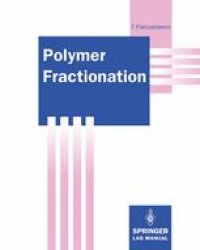
Ebook: Polymer Fractionation
- Tags: Industrial Chemistry/Chemical Engineering, Polymer Sciences, Analytical Chemistry
- Series: Springer Lab Manual
- Year: 1994
- Publisher: Springer-Verlag Berlin Heidelberg
- Edition: 1
- Language: English
- pdf
Fractionation of polymers via solubility has been a well known method in polymer characterization for a long time. The original object of analytical fractionations, the determination of the molecular weight distribution, is nowadays achieved more efficiently and conveniently by chromatographic methods. However, fractionation procedures, which were developed in great diversity, remain up~to-date and essential for obtaining preparative fractions with narrow distributions. Such fractions are wanted increasingly for the investigation of true structure-property relationships which are mostly influ~ enced by distributions of molecular weight or other parameters such as branching or chemical composition. Literature on the field of polymer fractionation is extensive and several reviews exist. However, there is a lack of systematically methodical instruc tions for carrying-out of diverse fractionation procedures. This volume repre sents an attempt to reduce this deficiency and is focussed on practical aspects of fractionation procedures. This laboratory manual is intended for polymer chemists, physicists, and technicians, for students of polymer science, and skilled laboratory assistants, all of whom are not dealing directly with fractionation but are in need of fractions to carry out further investigations.
The fractionation of polymers via differences in solubility, especially in a preparative scale, is an important presupposition for the determination of molecular weight-dependent polymer properties. In this book, a big variety of fractionation methods, their theoretical base, applications, equipments, preparatory and fractionation steps are discussed. The text is focussed on practical aspects of the carrying-out of polymer fractionations. Each fractionation procedure is completed by practical examples. Appendices and glossary are a useful supplement. The book will enable all polymer chemists, physicists and technicians as well as material scientists and students in these fields to choose the optimal fractionation variant for his problem.